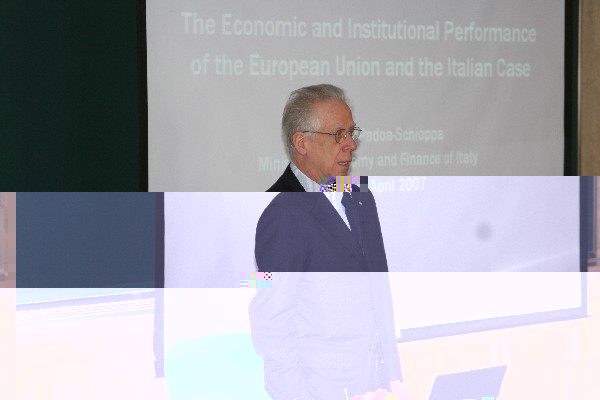On April 26,Minister of Economy and Finance of Italy Tommaso Padoa-Schioppa visitedSchoolofEconomicsand Management,TsinghuaUniversity(Tsinghua SEM) and delivered a speech entitled “The Economic and Institutional Performance of the European Union and the Italian Case”. Zhu Hengyuan, Associate Dean of Tsinghua SEM was present at the session.
Padoa-Schioppa’s speech began with the introduction of the Single European Market-----a cornerstone in European integration. The Single European Market provides free movement of people, goods, services and capital, as Padoa-Schioppa said, it means the possibility for EU citizens to live, work, study and do business throughout the European Union (EU). Padoa-Schioppa also introduced several key steps in European integration. The European integration, from the European Coal and Steel Community,European Economic Community, the European Union to the single currency, has become deeper and deeper, though it’s not a smooth process.

The Italian Ministerbriefed students about two important treaties which are considered as milestones for European integration: The Treaty of Rome and The Treaty of Maastricht. Signed in 1957, The Treaty of Rome, which gave birth to theEuropean Economic Community, committed member states to deeper economic integration through a Customs Union, free labor mobility, capital market integration and a range of common policies. The Treaty also set up a series of supranational institutions such as the European Parliament and the European Court of Justice. While the Treaty of Maastricht, which took effect in 1993, marked the transition of European Community to the European Union. With the Treaty of Maastricht, the EU committed itself to launching a monetary union by 1999 and introducing new banknotes and coins by 2002.The Treaty also established the EU’s current ‘three pillar’ structure.
Padoa-Schioppa talked about the Monetary Union and Euro System in his speech. According to Padoa-Schioppa, in order to join the Monetary Union, the applying country need to meet five convergence criteria of EU including the inflation rate, the membership of ERM (The European Exchange Rate Mechanism), long-term nominal interest rate, budget deficit, and public debt. The Monetary Union started in 1999 and Euro coins and notes were introduced in 2002.
Padoa-Schioppaalso talked about the EU economic performance and Italian case. Since mid 1990s,Italyhas seen lower GDP growth, higher inflation and fiscal deficit than that of the rest on the Euro area; while the country saw stronger employment gains as a result of labor market reforms. Recently the country has some signs of recovery, as Padoa-Schioppa said, Italy’s productivity growth has stopped declining; the growth is catching up to the area average; fiscal consolidation is on the way, and labor market is outperforming compare to most EU member states.
Padoa-Schioppa answered questions concerning the further European integration after the speech. Tommaso Padoa-Schioppa, who is in his sixties, assumed his post as Italian Economy and Finance Minister in May 2006. Before this, he has served as a member of the Executive board of the European Central Bank from 1998 to 2005.
| PPT document about Padoa-Schioppa's speech
PPT document about Padoa-Schioppa's speech
 Latest News
Latest News